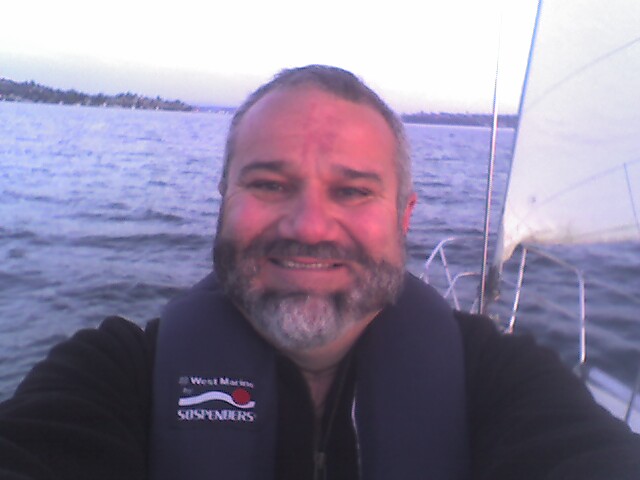Memorial Day to Olympia
Around 1400 on Thursday we headed over to the public dock just below Old Town Tacoma. We arranged to pick up my younger daughter there after school but discovered that facility is out of service – all of the docks aren’t in the water and the gangway to the pier is retracted. There’s a nice, new, public dock just to the West of the Old Town dock and we had that all to ourselves. It’s in front of the Silver Cloud Inn. It was low tide and a lady on shore, pretty alarmed, shouted “how deep is it there?” Scamper’s depth sounder showed 17’.
From Ruston Way, through the Narrows, and down to Eagle Island we had no wind but a fair current. Under power, we were making just under six knots through the water but our speed over the ground, according to the GPS, was never under eight knots – sometimes up to 11 knots. We made Eagle Island in less than two hours!
Eagle Island is a marine park and a really beautiful place. We managed to get a buoy on the West side of the island. Being a holiday weekend there was a lot of traffic in Balch Passage so there was plenty of wake into the anchorage but it was still a very pleasant evening. We went for a walk around Eagle Island and then had a spaghetti feed.
We dropped the buoy just after 1000 on Friday and had a pretty uneventful trip until we got to Budd Inlet, just in view of the capitol. The exhaust note changed, got louder, and stopped burbling, so I shut down the engine. Plenty of steam came out when I opened the cockpit hatch so it was obvious that raw water wasn’t getting circulated – the engine had started to overheat and the water-lift muffler had gone dry.
Suspecting debris in the strainer I climbed down into the cockpit locker and checked the screen. Pretty clean. I opened the through-hull and water flowed freely out of the now open strainer body (it is below the waterline).
I un-furled the genoa and was able to get about a half-knot of control while I did more troubleshooting.
I removed the companionway stairs and discovered the pulley for the raw water pump, along with the belt, laying in the bilge. The center hole in the pulley, where it mounts on the shaft, was very distorted – I suspect from a too-tight belt.
After a bit of thinking on the problem I decided to re-plumb the cooling system back to raw water only. I’ve never liked the fresh water system – some of the hose clamps were rusty and required replacement, the zinc was totally gone when I first looked at the boat. Things like that made me suspect it wasn’t a really good installation.
Amazingly, it only took about 10 minutes to get the system temporarily converted back to raw water cooling. I fired up the engine and we motored the rest of the way, about two miles, to Swantown Marina.
Swantown is a very nice marina but it is a pretty good walk to shore-side facilities. There’s a great Italian restaurant and an Anthony’s in the “Market”, about two miles away. There’s a Safeway about three miles away. All in all it was a nice stay but it was very crowded with several clubs staying for the holiday weekend.
There was really no hope of finding a replacement pulley in Olympia, especially on a holiday weekend so, on Saturday, I took a cab to West Marine. I bought a LOT of extra parts so I could make the raw water cooling conversion a bit more permanent for the ride home. I also incorporated a garden-hose flush connection so I can at least get the salt water out of the engine until I sort out the fresh-water-cooling problem.
My other daughter drove down on Saturday night, we had dinner, and everyone but my younger daughter and me left by car on Sunday morning. We departed Olympia in Scamper shortly after. We had the current going with us and were able to get from Olympia to Tacoma in under four hours with no further engine problems.
West Marine was great. I bought almost $100 in parts in Olympia, only used about $20 worth of them, and the Tacoma store gave me a refund on the parts I didn’t need with no questions asked. I used that money to buy another cabin fan. It was hot this weekend.

